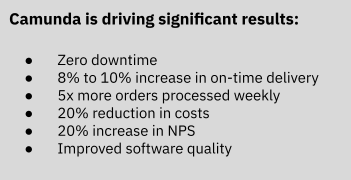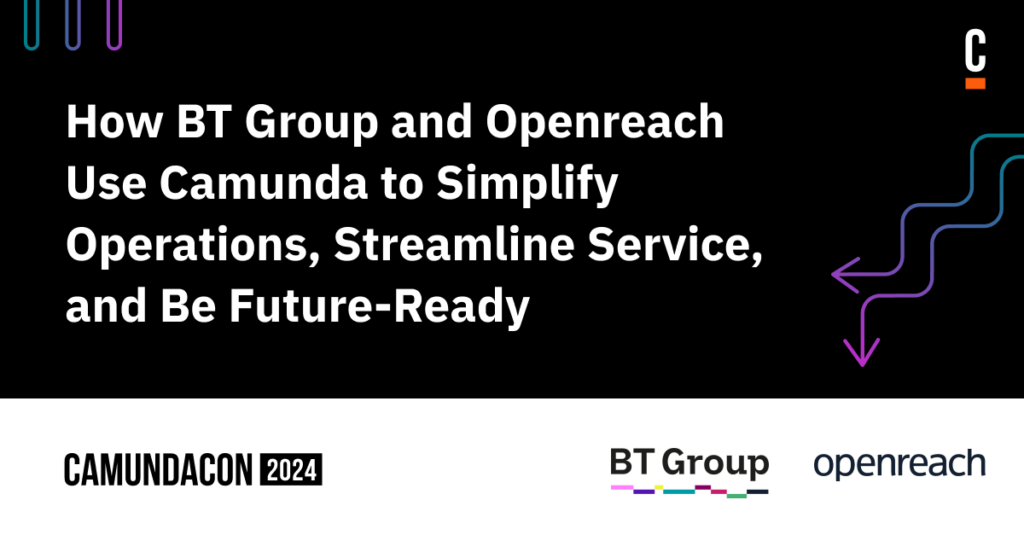Today, reliable, high-speed broadband connections are an absolute necessity. No business understands that better than Openreach Limited, the wholly owned subsidiary of BT Group responsible for building and maintaining the UK’s network of copper wires and fiber cables that connect 25 million homes and businesses to broadband across the country.
At the 2024 CamundaCon in New York City, Jonathan Wealls, product owner for Openreach, and Himanshu Nagpal, senior manager of software engineering at British Telecom, teamed up to share how Openreach and BT Group are using Camunda to transform their tech stack. The goal is to bring products to market faster and deliver efficient client services to more than 690 service providers, like Vodafone, Sky, TalkTalk, EE, and BT.
Simplifying a complex tech stack to be more adaptable
Openreach and BT Group were challenged by an archaic architecture built on unstructured, complex code. It slowed their time to market, required IT downtime during product rollouts, was incapable of processing high volumes of orders, and prevented visibility into real-time data.
Their existing orchestration engine could only handle about 8,000 orders per week. Often, multiple manual touchpoints were necessary within the process flow. This resulted in long lead times for any new product launch and very high delivery costs. Openreach and BT Group knew they needed a better way to provide first-class, cost-efficient product and customer journeys.
To find a process orchestration engine that could integrate into their complex tech stack and provide the functional capabilities to meet their strategic goals, BT Group conducted an extensive proof of concept, comparing their in-house orchestration tool with other BPMN orchestration tools. They assessed tools on their ability to build a complex journey and compared functional and technical capabilities against benchmarks for design and collaboration, recovery, monitoring, process orchestration, and development and testing.
“We looked at various themes, and clearly, Camunda stood out for us in the majority of those,” explained Himanshu.
The capabilities of Camunda’s process orchestration platform that stood out against the competition include:
- Design and collaboration: The team valued the ease of BPMN code use by developers, and the ability of Camunda to empower all stakeholders to model and collaborate on BPMN and DMN diagrams and related files. They also liked the ability to view defined processes through Camunda’s Modeler feature.
- Recovery: Camunda’s built-in APIs and Cockpit UI offered ease of recovery thanks to drag-and-drop functionalities and features. Camunda’s Tasklist helped with effective jeopardy management.
- Monitoring: Camunda Optimize provided process insight and monitoring through heat maps and process analytics. BPMN reporting and alerting capabilities enabled reports and dashboards specific to business needs.
- Orchestration engine: Camunda’s advanced workflow engine uses BPMN and DMN modeling standards, including configurable decision trees and data-driven development. The platform supports a microservices-based architecture, makes it very easy to roll back steps in an orchestration journey, and provides the agility and flexibility to deploy without any outage.
- Development and testing: Other standout qualities were the ability to reuse existing code, Camunda’s easy integration with in-house and third-party testing tools, and the ability for users to choose the interfacing code language (for BT Group, it’s Spring Boot Java).
Integrating Camunda with BT Group’s microservices architecture
According to Himanshu, Camunda seamlessly integrated with their existing systems through web services and IBM MQ. The team easily installed Camunda-embedded microservices, which were deployed as Docker images on the Kubernetes cluster. They applied a predefined schema offered by Camunda onto the database layer, allowing the system to interact with the workflow engine through APIs.
BT Group appreciated Camunda’s ability to use a PostgreSQL server to maintain and collaborate modifications to the BPM models. And they liked that they could use Camunda’s built-in Cockpit UI features to view the order of progression and the progress of deployed processes.
With the implementation of Camunda, BT Group and Openreach now have a highly resilient architecture that can communicate with upstream and downstream systems.
Getting new products to market faster
BT Group and Openreach were able to soft launch their first strategic product in nine months with zero servicing impacts during migration.
Originally, the team planned to use Camunda to strategically transform one product. However, the benefits of moving to Camunda were so significant that BT Group embarked on additional projects to improve their lead-to-cash processes.
Collaborating with the business team from Openreach, they built an Order Manager business process to better manage complex civil infrastructure work, such as the permitting and activities related to the installation of new poles, ducting, and road work. The new process reduces the previous three or four systems needed to progress an order into one centrally located system with a web-based user interface. Now, if an engineer on the ground needs permits from a local council, the request is in a desk user’s inbox within seconds, reducing fallout times.
The new Camunda-based process has helped Openreach increase the number of orders ready for work. With the ability to process more orders more quickly and accurately, they’ve seen an increase in their NPS score, as well.
BT Group has also migrated two additional strategic products to the new Camunda platform: one that existed on their old stack and another that was built from scratch and onboarded to the platform. They are on track to launch their third strategic product pilot in 2025.
Seeing the benefits of the Camunda platform
Camunda is helping Openreach improve operations and customer service through process orchestration. “We’re faster to market, we’ve streamlined our processes, and we have very high availability under deployment,” said Jonathan.
Now, the team uses an Agile delivery model to deliver new minimum viable products every two weeks and is seeing improvement across its four main pillars:

- Faster to market: Enhanced collaboration between technology and business; streamlined processes; and the ability to scale rapidly.
- Business continuity: Seamless integration with existing systems; high availability with zero downtime on deployments; and robust process automation.
- Transformation: Real-time business analytics through Optimize; rapid innovation with journey changes, new developments, and new products coming to market; and improved operational efficiency by removing downtime.
- Financial: Enhanced efficiency due to zero fallouts; reduced infrastructure costs; reduced downtime; deployments done within seconds; and the ability to process orders as fast as they can.
“It’s a collaboration between Openreach and BT Technology that has enabled all these benefits to be realized for the business,” shared Jonathan. He emphasized that to be successful, “You’ve got to have that full collaboration going on… Bring the business on the journey of the process orchestration changes.”
In a recent interview with Camunda, Jonathan elaborated on Openreach’s continued commitment to move from Camunda 7 to Camunda 8.
Transforming business processes and enterprise stack
With the new Camunda platform, BT Group and Openreach can now process data in real time. Optimize and other out-of-the-box tools are helping them improve business performance and provide the level of service and reliability expected by their valued customers. They are also working closely with Camunda experts to plan their migration to Camunda 8 so they can take advantage of additional Connectors and new AI integrations.
Openreach and BT Group’s story is one example of how organizations can take a phased approach to transforming complex, legacy systems. Watch the session replay for more details on their project, and check out all the video replays from CamundaCon New York City 2024.




Start the discussion at forum.camunda.io